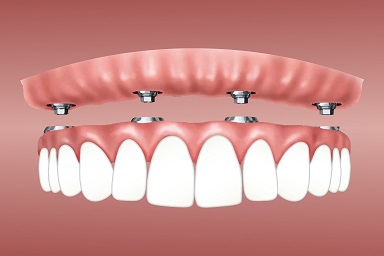Are ceramic dental implants better than titanium implants?
Ceramic implants as tooth replacements are becoming increasingly popular given that they can not be differentiated from healthy teeth by color and that they offer a metal-free alternative to titanium. But what are the pros and cons of ceramic implants as compared to titanium implants? And how do their relative costs stack up? The following blog post answers these important questions and goes into additional details.Index
- What are ceramic implants made of and how are they used?
- Advantages of ceramic implants – more than just innovative
- Disadvantages of ceramic implants
- Comparison: Pros and Cons of titanium implants
- Cost: How expensive are ceramic implants?
What are ceramic implants made of and how are they used?
The term "ceramic implant" is colloquial and stands for dental implants that are made out of the very robust material called zirconium oxide. It is not only used in dental implants but also in dental bridges and inlays. A dental implant can be used to replace a tooth as well as to serve as an anchor for a dental prosthetic.Ceramic implants can came in one piece or consist of two pieces: one-piece implants are usually used as stabilizers for dental prosthetics as well as for crowns and bridges. Two-part implants consist of a screw and an abutment (the piece that connects the screw to the dental crown) which are glued together to provide for maximum flexibility during the customization process.

What are the advantages of ceramic implants?
Ceramic implants are praised as the metal-free alternative to otherwise commonly used types of dental implants. The most important advantages of these implants are:- Metal-free: The optimal alternative for patients with metal allergies.
- Better tolerance: For patients with diseases such as diabetes, rheumatoid arthritis, and circulatory system issues, ceramic implants are the go-to option.
- Lower inflammation risk: Ceramic implants are the least conducive to bacteria growth among all implant types.
- Prevention of receding gums: Gums regenerate much more quickly around ceramic implants than around titanium implants.
- Aesthetic point of view: Titanium implants often show through a thin gum line, while ceramic implants look much more natural around healthy teeth.
What are the disadvantages of ceramic implants?
Ceramic implants have been rising back to popularity only in the past few years, which is why there are no longer-term studies yet, that can clearly prove the better tolerance to the material. The major drawbacks of ceramic implants are:- Higher costs: In general, the working time for the dentist is higher than for titanium implants and the fitting process is also more lengthy, which is why ceramic implants cost more than titanium implants.
- Longer healing time: While the healing process for titanium implants lasts only between 6 and 12 weeks, ceramic implants usually require up to 24 weeks to completely settle into a patient's jaw. They can not immediately carry as much pressure as a healthy tooth and sometimes even need to be supported by a splint for a while, which further contributes to their higher cost.
- Less flexibility: With the one-piece version, an additional drawback is that the implant often has to be custom cut to ensure a proper fit, which makes it less flexible during the placement process.

What are the Pros and Cons of titanium implants?
Titanium implants have been used for decades by now and are considered reliable and long-lasting / robust. Bone mass very easily wraps itself around the artificial tooth root made out of titanium and the so-called "osseointegration" works without any problems. From a flexibility and stability standpoint, it has very similar attributes as bone mass itself, which makes it a very well-tested tooth replacement. Many dentists continue to count on titanium because of their many years of positive experience with the material. However, as already mentioned above, the risk of inflammation is significantly higher and patients with metal allergies as well as those suffering from certain diseases should not get titanium implants.How expensive are ceramic implants?
To provide a general cost statement for a dental implant placement is very difficult because the exact costs depend heavily on the used materials, the type of implant (1-piece or 2-piece), and the of the sequence of the implantation procedure.If an implant is to be placed in the non-visible part of the mouth (side teeth), costs can start at EUR 2.000 for individual teeth. Costs for implant bridges start at roughly EUR 4.500. For exact details, always ask about costs prior to a procedure and make sure to find out whether insurance pays for part of it. Some Austrian insurers pay anywhere between EUR 200 and EUR 700 for implants and some private insurers may pay even more.
In the meantime, we would love to hear from you – please leave any thoughts and feedback in the comment box below and subscribe to our blog through a free subscription for more interesting articles.


